Posts by Christopher Lochhead
385 Silicon Valley’s Secret Marketing Assassin Rick Bennett
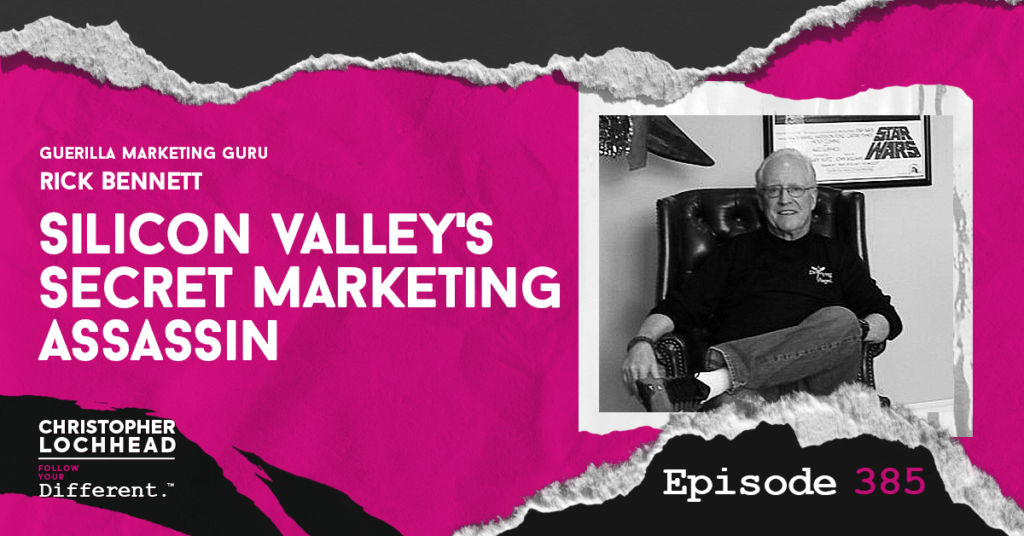
Podcast: Play in new window | Download (Duration: 1:14:34 — 68.3MB) | Embed
Subscribe: Apple Podcasts | Spotify | Pandora | RSS | More
On this episode of Christopher Lochhead: Follow Your Different, we get a blast from the past from a legendary dialogue with Rick Bennett, a renowned marketing expert from Silicon Valley.
We delve into unconventional marketing strategies, emphasizing the importance of boldness and creativity in a crowded market. Rick shares anecdotes about impactful campaigns, such as a direct ad to a CEO that led to a significant response, and discusses the necessity of courage in marketing.
The episode highlights the psychological impact of disruptive advertising on competitors and clients, encouraging executives to embrace risk for standout success. Christopher’s engaging style and Rick’s authentic insights make this a must-listen for marketing enthusiasts.
You’re listening to Christopher Lochhead: Follow Your Different. We are the real dialogue podcast for people with a different mind. So get your mind in a different place, and hey ho, let’s go.
Creating Memorable Marketing Tactics
Rick Bennett is celebrated for his ability to craft ads that not only capture attention but also provoke strong reactions. One of the standout moments in the episode is Christopher’s recollection of Rick’s iconic website from 1996. This site was more than just a digital presence; it was a masterclass in contextualizing advertisements within the competitive landscape.
Rick shares an intriguing story about creating an ad for a political candidate designed to catch the eye of Sergey Brin at Google. The ad claimed the candidate had a revolutionary plan to eliminate income taxes and the national debt. This bold approach succeeded in getting the candidate a direct call from Brin, showcasing the power of direct and audacious communication.
Vetting Executives for Courage
Christopher probes Rick about how he assesses the courage of CEOs when considering collaboration.
Rick introduces the concept of a “self-weeding garden,” a metaphor for identifying the right clients. He emphasizes the importance of being straightforward and authentic, stating, “God hates cowards,” to underline the necessity of courage in marketing.
Christopher praises Rick for being unapologetically himself, noting that his authenticity sets him apart in the industry. Rick recounts his early experiences, including a pivotal moment with Larry Ellison, where he confidently challenged Ellison’s views on advertising. This encounter not only solidified Rick’s reputation but also transformed Ellison into an advocate for advertising.
Guerilla Marketing: Making Generals Surrender
Rick shared some important insights about guerilla marketing. One of the goals of guerilla warfare is to make the generals of the opposing army make mistakes.
“My ads will attack your competition like a pack of speedy, crazed wolverines”
– Rick Bennett
He adds, “Demoralize the generals of the opposing army, then they’ll make mistakes. You have your investors to say, ‘Hey we have a winner here’ and you have to make the employees feel that their boss is kicking ass.”
In the end, marketers should aim for a campaign where you make opposing generals psychologically surrender, even before any battle has begun.
To hear more from the Marketing Assassin Rick Bennett, download and listen to this episode.
Bio
Rick Bennett is a renowned Silicon Valley guerrilla marketing expert with decades of experience helping startups and tech companies achieve explosive growth through unconventional and impactful strategies.
Known for his innovative thinking and bold approach, Rick has a proven track record of creating campaigns that maximize reach and engagement while minimizing costs.
Passionate about empowering businesses to stand out in competitive markets, he continues to be a trusted advisor and mentor for entrepreneurs seeking game-changing marketing solutions.
Link
Follow Rick Bennett!
Website | LinkedIn
We hope you enjoyed this episode of Christopher Lochhead: Follow Your Different™! Christopher loves hearing from his listeners. Feel free to email him, connect on Facebook, Twitter, Instagram, and subscribe on iTunes!
384 Innovation Under Pressure: Judah Taub on the Power of Israeli Entrepreneurial Spirit
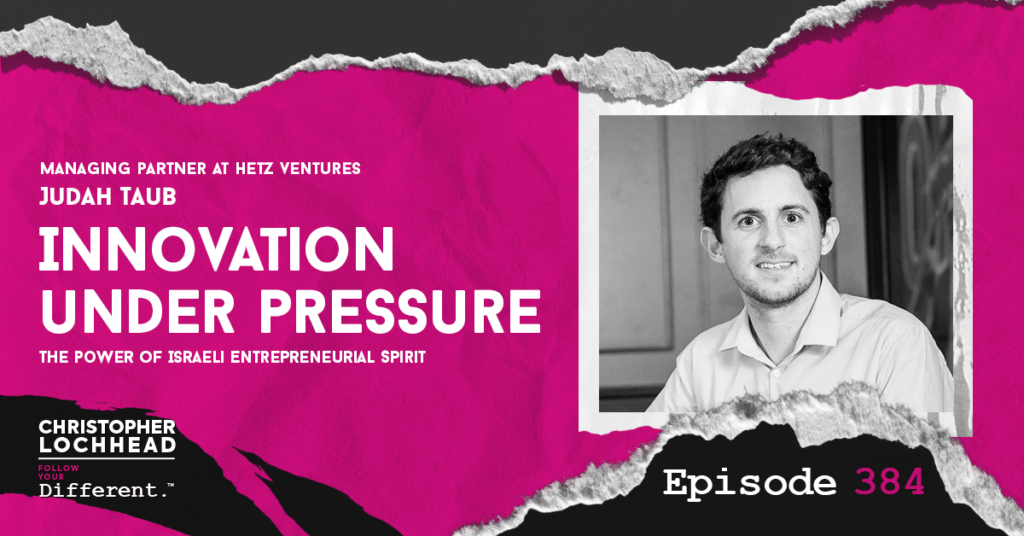
Podcast: Play in new window | Download (Duration: 1:00:57 — 41.8MB) | Embed
Subscribe: Apple Podcasts | Spotify | Pandora | RSS | More
On this episode of Christopher Lochhead: Follow Your Different, the spotlight is on the resilience and unique challenges faced by Israeli entrepreneurs as we have a conversation with Judah Taub, managing partner at Hetz Venture Capital.
Judah shares insights on the Israeli tech startup ecosystem, the profound impact of military service, and the remarkable adaptability of entrepreneurs, especially following the traumatic events of October 7th.
This dialogue highlights the intertwined nature of personal and professional lives in Israel, showcasing the enduring spirit and innovation that drive the entrepreneurial community amidst adversity.
You’re listening to Christopher Lochhead: Follow Your Different. We are the real dialogue podcast for people with a different mind. So get your mind in a different place, and hey ho, let’s go.
Judah Taub on Military Service and Society
Judah Taub discusses the integral role of military service in Israeli society, emphasizing how it creates a shared experience that binds citizens together. He shares an anecdote about speaking to West Point cadets, highlighting the differences between their backgrounds and those of Israelis. In Israel, military service fosters a collective sense of urgency and responsibility, particularly during crises.
The Impact of Recent Events & Processing Trauma
The conversation shifts to October 7th, a day that transformed from a high holy day to one of duty for Judah and his family, as they were called back into military service. This rapid transition underscores the unpredictable nature of life in conflict zones and its profound personal impact.
Judah remembers the emotional toll of sudden changes, noting that the reality of the situation didn’t fully sink in until a week later. This highlights the struggle of processing trauma amidst chaos and the importance of recognizing different coping mechanisms.
Entrepreneurship Amidst Adversity
Despite challenges, Judah highlights the resilience of Israeli entrepreneurs, who thrive on innovation and determination. The ability to adapt and pivot is crucial for success in uncertain environments.
Judah then reflects on balancing multiple roles over the past year, including military service and entrepreneurial endeavors. He hope for the future, emphasizing the resilience of the Israeli spirit. Despite challenges, there is a strong foundation for recovery and growth within the entrepreneurial community.
To hear more from Judah Taub and the power to innovate even at the most dire situations, download and listen to this episode.
Bio
Judah Taub is an Israeli entrepreneur known for his innovative approach to business and technology.
As the managing partner at Hetz Ventures, he has played a pivotal role in investing in and supporting early-stage startups, helping them scale and succeed globally.
Judah’s expertise spans venture capital, product development, and strategic growth, with a focus on fostering innovation in deep tech and enterprise software.
Passionate about empowering entrepreneurs, he combines analytical insights with hands-on mentorship, making him a respected figure in Israel’s vibrant tech ecosystem and beyond.
Links
Follow Judah Taub!
LinkedIn | X (formerly Twitter) | Hetz Ventures
We hope you enjoyed this episode of Christopher Lochhead: Follow Your Different™! Christopher loves hearing from his listeners. Feel free to email him, connect on Facebook, Twitter, Instagram, and subscribe on iTunes!
208 Clarity in Your Category POV with Katrina Kirsch | Pirate Jam
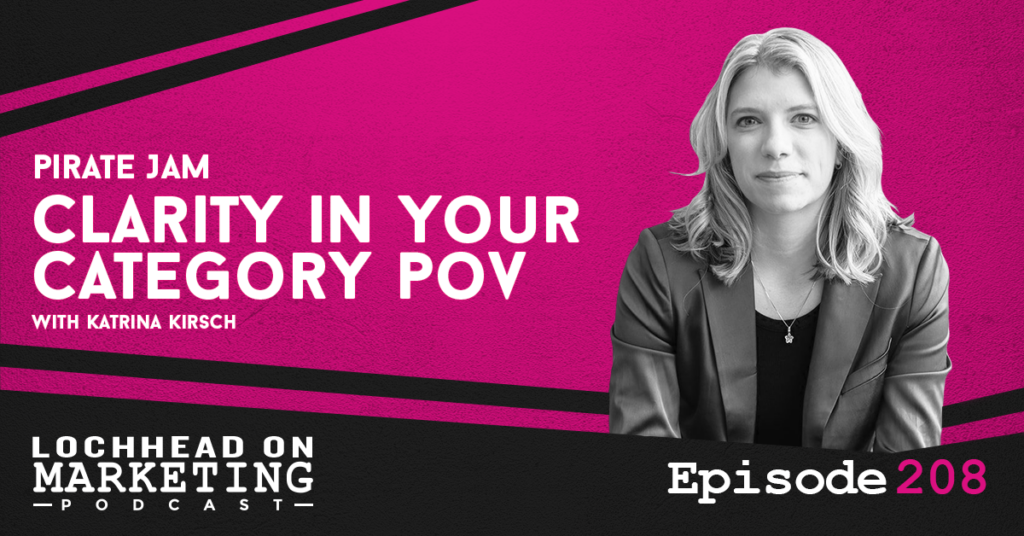
Podcast (lochheadonmarketing): Play in new window | Download (Duration: 48:34 — 33.3MB) | Embed
Subscribe: Apple Podcasts | Spotify | RSS | More
On this episode of Lochhead on Marketing, we dive deep with fellow Category Pirate Katrina Kirsch into the critical importance of clarity in marketing.
We explore the common pitfalls that entrepreneurs and marketers face when trying to articulate their points of view (POVs) and the challenges of standing out in a crowded marketplace.
This episode will break down the key insights from their discussion, and offer thorough explanations & actionable advice to help you refine your marketing strategies.
Welcome to Lochhead on Marketing. The number one charting marketing podcast for marketers, category designers, and entrepreneurs with a different mind.
Katrina Kirsch on the Challenge of Clarity in Marketing
Christopher opens the discussion by highlighting a prevalent issue: many marketing messages are convoluted and fail to convey the core message clearly. He points out that when potential customers visit a company’s website, they often leave feeling confused about what the business actually does. This confusion stems from the tendency of companies to overcomplicate their messaging, using jargon and clever phrasing that ultimately obscures their value proposition.
Katrina agrees, sharing her experiences with creatives who often fall into the trap of trying to be overly clever in their marketing. She emphasizes that while creativity is essential, it should not come at the cost of clarity. The duo stresses that the most effective marketing is straightforward and easy to understand. They argue that clarity is not just a nice-to-have; it is a fundamental requirement for successful marketing.
The Power of Simplicity
The conversation shifts to the power of simplicity in messaging. Christopher cites Walmart’s tagline, “Save money. Live better,” as an example of effective simplicity. This tagline is memorable and communicates the brand’s value proposition clearly. He contrasts this with the overly complex messaging often found in the tech industry, where companies may describe their products in multiple ways, leading to confusion rather than clarity.
Katrina shares a story about a photography club leader who was preparing to launch a virtual camp. The leader’s email communications were filled with clever but confusing language, including hidden links and overly complex descriptions. After reviewing the emails together, Katrina advised him to prioritize clarity over cleverness. She emphasizes that when communicating with an audience, especially those unfamiliar with the subject matter, it is crucial to be as clear as possible.
Katrina Kirsch on the Dangers of Overcomplication
Christopher and Katrina discuss how the desire to sound smart can lead to overcomplicated messaging. They reference a smart startup CEO who, despite his intelligence, produced a press release that described the company’s product in six different ways. This lack of consistency made it difficult for readers to understand what the company actually did. Christopher points out that this is a common mistake among intelligent individuals who may feel the need to showcase their knowledge through complex language.
Katrina adds that in certain fields, such as academia or science, complexity can be valued. However, in marketing, especially for solopreneurs and small businesses, clarity should take precedence. The speakers agree that the goal should be to communicate the problem being solved and the solution offered in the simplest terms possible.
To hear more from Katrina Kirsch on the Importance of having a clear POV, download and listen to this episode.
Bio
Katrina Kirsch is a skilled content strategist and writer specializing in creating impactful marketing strategies and engaging content.
With a background in journalism and digital marketing, Katrina has a talent for crafting clear, compelling messages that resonate with diverse audiences. She excels in SEO, social media management, and brand storytelling, helping businesses build strong online presences.
Passionate about connecting ideas with people, Katrina stays ahead of industry trends to deliver innovative solutions. Her dedication to quality and creativity has earned her a reputation as a trusted professional committed to driving meaningful results for her clients and collaborators.
Links
Follow Katrina Kirsch!
Website | LinkedIn | X (formerly Twitter)
We hope you enjoyed this episode of Lochhead on Marketing™! Christopher loves hearing from his listeners. Feel free to email him, connect on Facebook, Twitter, Instagram, and subscribe on iTunes!
382 The Discipline of a Champion: Rickson Gracie’s Philosophy of Presence, Power, and Peace

Podcast: Play in new window | Download (Duration: 1:13:32 — 50.5MB) | Embed
Subscribe: Apple Podcasts | Spotify | Pandora | RSS | More
On this episode of Christopher Lochhead: Follow Your Different, we are treated to a profound conversation with Rickson Gracie, a legendary figure in Brazilian Jiu-jitsu.
Known for his unparalleled contributions to martial arts and his deep philosophical insights, Rickson Gracie shares his wisdom on life, purpose, and spirituality.
Rickson also discusses the significance of being present, engaging authentically in relationships, and cultivating a sense of purpose. His philosophy extends beyond the mat, offering valuable lessons in personal growth and mindfulness, encouraging listeners to embrace resilience and inner strength in their daily lives.
You’re listening to Christopher Lochhead: Follow Your Different. We are the real dialogue podcast for people with a different mind. So get your mind in a different place, and hey ho, let’s go.
Rickson Gracie on the Nature of Competition in Jiu-Jitsu
Rickson Gracie begins by highlighting a unique aspect of jiu-jitsu: the ability to compete intensely without causing injury. Unlike striking arts such as boxing, jiu-jitsu incorporates the concept of “tapping out,” allowing practitioners to engage fully while maintaining safety. This dynamic foster a learning environment where losing is seen as an integral part of growth.
Gracie also emphasizes the significance of being present, a practice that is central to jiu-jitsu. On the mat, practitioners must focus entirely on the moment, leaving behind external distractions. This mindfulness not only enhances performance but also translates to everyday life, fostering a sense of calm and clarity.
Rickson Gracie on Engagement and Connection in Relationships
The conversation then touches on the importance of genuine engagement in relationships. Gracie reflects on how technology has altered social interactions, often leading to superficial connections. He argues that martial arts training can help individuals reconnect with the essence of human interaction, fostering deeper connections through shared experiences and presence.
Rickson Gracie on Finding and Fulfilling Your Purpose & Building Inner Strength
Rickson Gracie discusses the concepts of purpose and service, highlighting that happiness is a dynamic process requiring effort and intention. He encourages listeners to identify their commitments and responsibilities, whether to family, work, or personal growth. Taking care of oneself is essential to being able to serve others effectively.
On that note, Gracie opens up about his personal challenges, including his battle with Parkinson’s disease. He approaches this new opponent with a strategic mindset, focusing on resilience and adaptability. He emphasizes the importance of understanding oneself and developing a strong sense of inner peace to navigate life’s difficulties.
To hear more from Rickson Gracie and his philosophies on the mat & in life, download and listen to this episode.
Bio
Rickson Gracie is a legendary Brazilian Jiu-Jitsu master and MMA pioneer, celebrated for his mastery, discipline, and contributions to martial arts.
A member of the renowned Gracie family, Rickson holds an 8th-degree red-and-black belt and has achieved an unparalleled level of skill and influence.
Known for his philosophy of mind-body connection and his undefeated record in over 400 fights, he remains an iconic figure in the jiu-jitsu world, inspiring practitioners globally.
Links
Follow Rickson Gracie!
We hope you enjoyed this episode of Christopher Lochhead: Follow Your Different™! Christopher loves hearing from his listeners. Feel free to email him, connect on Facebook, Twitter, Instagram, and subscribe on iTunes!
207 Write Your Way to Market Leadership: Fernando Labastida on How Writing a Book Shapes New Markets
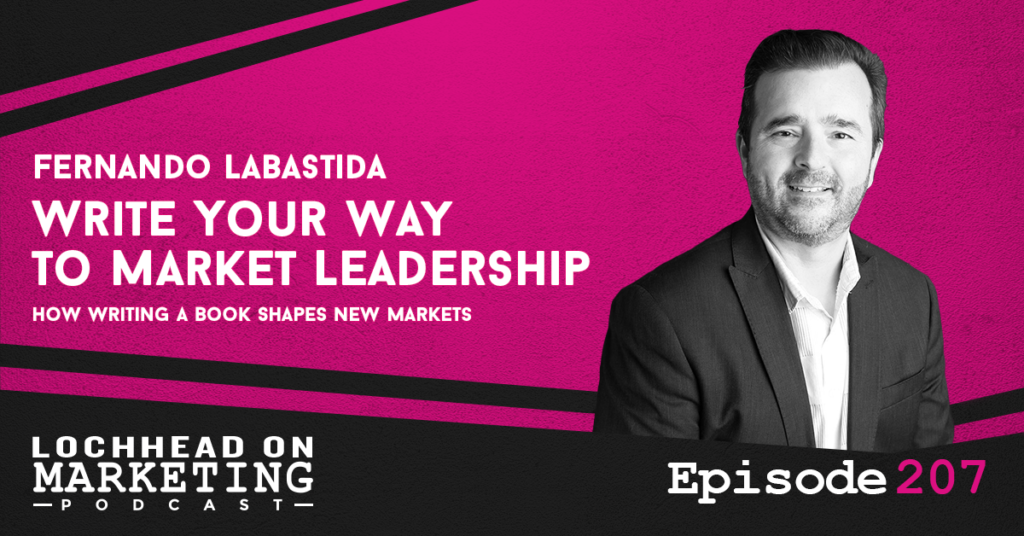
Podcast (lochheadonmarketing): Play in new window | Download (Duration: 1:05:08 — 44.7MB) | Embed
Subscribe: Apple Podcasts | Spotify | RSS | More
On this episode of Lochhead on Marketing, we engage in a thought-provoking conversation with Fernando Labastida, an innovative thinker in category design and a proponent of businesses creating their own unique markets.
The discussion centers on the transformative role of writing a book as a strategy for businesses to carve out their unique markets and establish themselves as category leaders.
Welcome to Lochhead on Marketing. The number one charting marketing podcast for marketers, category designers, and entrepreneurs with a different mind.
Fernando Labastida on the Value of Writing a Book
Fernando Labastida begins by discussing the advantages of writing a book, asserting that it can serve as a powerful means to organize and galvanize ideas. He notes that while it’s possible to design a category without writing a book, the process of writing can clarify thoughts and solidify concepts.
Fernando likens writing a book to assembling a puzzle or using a paint-by-numbers coloring book, where a detailed outline helps structure the ideas.
He also highlights how a book can kickstart marketing efforts, enabling authors to engage in “information wars” and “air wars” to evangelize their categories. A book can open doors to speaking engagements, podcast appearances, and networking opportunities, amplifying the author’s message across various platforms.
The Impact of Being an Author
Christopher shares a personal anecdote about the impact of being a published author. He recounts a recent experience in Fiji, where a stranger recognized him as one of the authors of “Play Bigger” and expressed how the book had changed his life and business. This moment underscores the profound effect that a book can have on readers, creating a lasting connection that is often more impactful than other forms of media, such as podcasts or blogs.
Fernando posits that in an age where attention spans are dwindling, writing a book demonstrates a commitment to deep thinking and sustained effort, which can resonate with audiences.
Creating New Language and Thought Leadership
The conversation shifts to the importance of language in establishing thought leadership. Christopher points out that those who create new language often dominate their categories. He cites Starbucks as an example, where the company’s unique terminology has shaped customer expectations and industry standards.
Similarly, he discusses how ChatGPT has redefined language around artificial intelligence, introducing terms like “large language model” and “prompt engineer,” which have become integral to the conversation about AI.
Fernando echoes this sentiment, referencing the Eisenberg brothers, who coined terms like “conversion rate optimization” to describe emerging concepts in digital marketing. He emphasizes that new problems arising from technological advancements necessitate new solutions and, consequently, new language to describe them.
To hear more from Fernando Labastida and the legendary value of writing a book, download and listen to this episode.
Bio
Fernando Labastida is a seasoned marketing strategist known for his expertise in content marketing and business growth. He has helped tech companies and startups build brand authority through strategic storytelling, connecting businesses with their target audiences.
Passionate about innovative growth, Fernando excels in crafting compelling narratives that drive engagement and customer loyalty, making him a trusted leader in tech marketing who skillfully blends strategy with creativity to achieve impactful results.
Links
Follow Fernando Labastida!
We hope you enjoyed this episode of Lochhead on Marketing™! Christopher loves hearing from his listeners. Feel free to email him, connect on Facebook, Twitter, Instagram, and subscribe on iTunes!
381 Chicken Cock Whiskey & The King: Matti Anttila on the Art of Brand Revival and Celebrity Partnerships
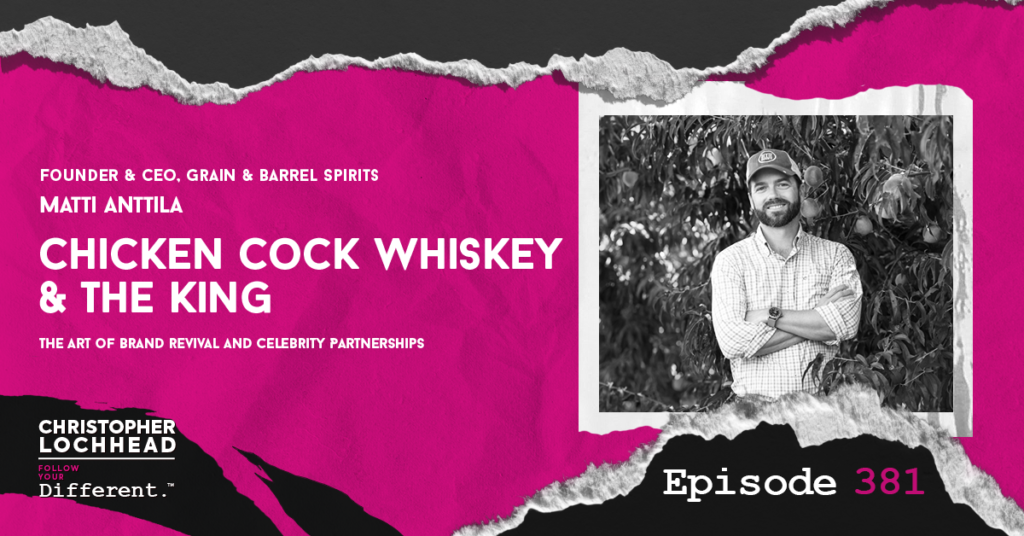
Podcast: Play in new window | Download (Duration: 1:20:35 — 55.3MB) | Embed
Subscribe: Apple Podcasts | Spotify | Pandora | RSS | More
On this episode of Christopher Lochhead: Follow Your Different, we have a conversation with Matti Anttila, the visionary founder of Grain and Barrel Spirits.
Matti shares his remarkable journey from investment banking to becoming a leader in the craft spirits market, focusing on the revitalization of the iconic Chicken Cock whiskey brand. He discusses the importance of brand authenticity, leveraging history, and the unique identity of Chicken Cock.
The episode also explores Matti’s collaboration with the Elvis Presley estate, enhancing the brand’s allure. Matti emphasizes experiential engagement and strategic partnerships to differentiate in a competitive market, offering valuable insights for entrepreneurs in the spirits industry.
You’re listening to Christopher Lochhead: Follow Your Different. We are the real dialogue podcast for people with a different mind. So get your mind in a different place, and hey ho, let’s go.
Matti Anttila: From Investment Banking to Craft Spirits
Matti’s transition from a lucrative career in investment banking to the unpredictable world of spirits was driven by a desire to create something meaningful. His background in real estate development fueled his passion for building something from the ground up, allowing him to see his ideas come to life.
Transitioning to a new industry can be daunting, but pursuing what he loves has led to greater fulfillment and success. By utilizing his previous experiences and skills, Matti was able to build a strong foundation in his new venture.
Differentiating in a Competitive Market: Identifying White Space & Leveraging History
Matti emphasizes that true innovation often comes from outside the industry. When entering the spirits market, he sought to identify “white space” within established categories, allowing him to avoid the challenge of educating consumers about what whiskey or bourbon is. This approach enabled him to carve out a unique niche for Chicken Cock whiskey.
Another significant part of Matti’s strategy involved leveraging history. He recognized that whiskey is a category where history plays a crucial role. By resurrecting Chicken Cock, a brand with roots dating back to 1856, he tapped into a rich heritage that added depth to the brand’s narrative.
Matti Anttila & The Power of a Distinctive Name
The name “Chicken Cock” itself was a major draw for Matti. It not only piqued his curiosity but also served as an effective conversation starter. The brand’s history, including its prominence at the Cotton Club during prohibition and mentions by figures like Duke Ellington, added to its allure.
Matti believes that word-of-mouth marketing is one of the most powerful tools for any brand. Chicken Cock’s distinctive name naturally fosters conversations, making it easier to engage consumers and build brand awareness.
To hear more from Matti Anttila and his thoughts on how to revive a brand to something legendary, download and listen to this episode.
Bio
Matti Anttila is the founder & CEO of Grain & Barrel Spirits, an innovative company specializing in crafting and marketing premium spirits.
With a passion for authenticity and quality, Matti has revived historic brands and introduced new, award-winning products like Chicken Cock Whiskey, Dixie Vodka, and Endless Summer Spirits.
His approach combines an appreciation for tradition with a modern, entrepreneurial spirit, leading Grain & Barrel to rapid growth in the global spirits industry.
Matti’s leadership and dedication to brand authenticity have made Grain & Barrel Spirits a standout in the market, recognized for its distinctive, high-quality offerings.
Links
Follow Matti Anttila!
Website | LinkedIn | Interview with Matti
We hope you enjoyed this episode of Christopher Lochhead: Follow Your Different™! Christopher loves hearing from his listeners. Feel free to email him, connect on Facebook, Twitter, Instagram, and subscribe on iTunes!
206 The One-Sentence Strategy | Pirate Jam

Podcast (lochheadonmarketing): Play in new window | Download (Duration: 10:15 — 7.0MB) | Embed
Subscribe: Apple Podcasts | Spotify | RSS | More
On this episode of Lochhead on Marketing, Category Pirates Christopher Lochhead and Eddie Yoon talk about the power of simplifying business strategies into a One-Sentence Strategy.
They discuss how successful companies, from large enterprises to solopreneurs, leverage concise strategies to drive focus and alignment. Highlighting examples like Gillette’s “revenue per user per year” and Microsoft’s “a computer on every desktop,” they emphasize the importance of clarity and customer-centric approaches.
The episode underscores that while crafting a one-sentence strategy is challenging, it is essential for achieving cohesive company culture and long-term success.
Welcome to Lochhead on Marketing. The number one charting marketing podcast for marketers, category designers, and entrepreneurs with a different mind.
The Power of Having One Clear Strategy
Eddie Yoon emphasizes that the most successful businesses, regardless of their size, often operate under a singular, clear metric or strategy. This simplicity allows for better focus and alignment across the organization. He cites the example of Gillette, which used “revenue per user per year” (RUPI) and “profit per user per year” (PUPI) as their guiding metrics. This approach not only streamlined their decision-making but also ensured that all team members understood their primary objectives.
Christopher & Eddie then give examples of several legendary companies that have thrived due to their clear, concise strategies. For instance, Microsoft’s one-sentence strategy was “a computer on every desktop,” which guided their product development and marketing efforts for decades. Similarly, YETI, known for its premium ice coolers, positioned itself with the straightforward strategy of offering a “premium ice cooler,” differentiating itself from traditional, lower-cost options.
The Importance of Customer Focus
They also point out how these companies maintain a customer-centric approach. For example, the Keurig coffee system was built around the idea of convenience and choice, with the metric of “K-cups per brewer per day” driving their business decisions. This focus on customer experience and satisfaction is crucial for long-term success.
Christopher explains that while these strategies are simple to understand, executing them effectively is often challenging. He notes that when a company has a clear strategy, it becomes easier to align employees, investors, and customers towards a common goal. This alignment is essential for fostering a cohesive company culture and driving growth.
The Challenge of Crafting a One-Sentence Strategy
Creating a one-sentence strategy is not a straightforward task. It requires deep reflection and a thorough understanding of the business’s core mission and values.
Christopher & Eddie discuss how many organizations settle for vague or overly complex strategies, which can lead to confusion and misalignment. They advocate for a rigorous process of distillation, where businesses must sift through their ideas and focus on what truly matters.
One of the standout examples is the Ritz-Carlton’s guiding principle: “Ladies and gentlemen serving ladies and gentlemen.” This simple yet profound statement encapsulates their commitment to exceptional service and sets a high standard for their employees. It illustrates how a well-crafted strategy can inspire and elevate a brand’s identity.
To hear more From Christopher & Eddie about the One-Sentence Strategy, download and listen to this episode.
Want to hear more Pirate Jams? Head on over to Category Pirates and enjoy more conversations between Category Pirates Christopher & Eddie!
Don’t forget to grab a copy (or gift!) of one of our best-selling books:
Snow Leopard: How Legendary Writers Create A Category Of One
The Category Design Toolkit: Beyond Marketing: 15 Frameworks For Creating & Dominating Your Niche
A Marketer’s Guide To Category Design: How To Escape The “Better” Trap, Dam The Demand, And Launch A Lightning Strike Strategy
 The 22 Laws of Category Design: Name & Claim Your Niche, Share Your POV, And Move The World From Where It Is To Somewhere Different
The 22 Laws of Category Design: Name & Claim Your Niche, Share Your POV, And Move The World From Where It Is To Somewhere Different**NEW!** The B2B Tech Marketer’s Guide To Category Design: How To Engineer Your Market, Find What Makes You Different, And Become A Category Queen
We hope you enjoyed this episode of Lochhead on Marketing™! Christopher loves hearing from his listeners. Feel free to email him, connect on Facebook, X (formerly Twitter), Instagram, and subscribe on iTunes and Spotify!
379 Breaking the Cycle of Competition: Seth Godin on Winning Your Own Game
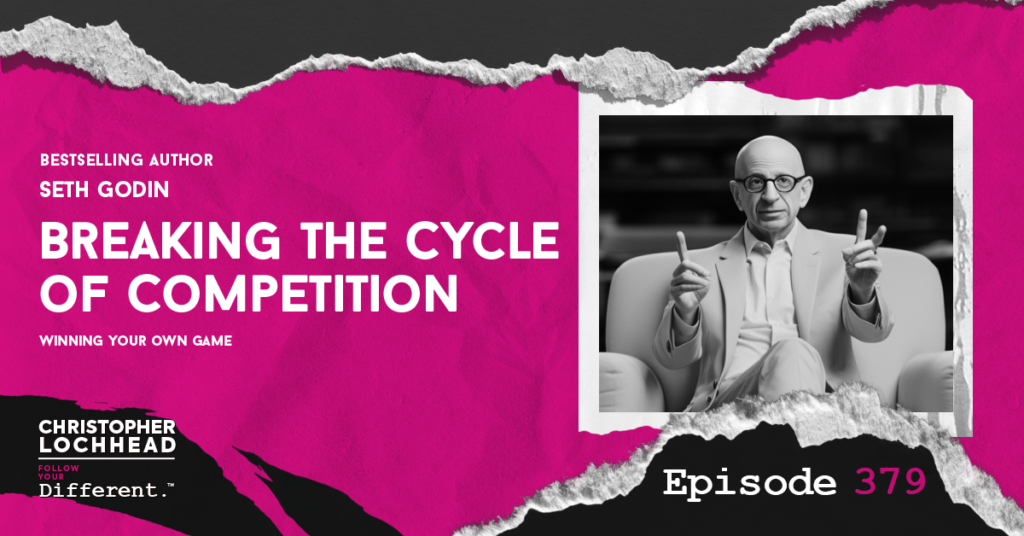
Podcast: Play in new window | Download (Duration: 54:28 — 37.4MB) | Embed
Subscribe: Apple Podcasts | Spotify | Pandora | RSS | More
On this episode of Christopher Lochhead: Follow Your Different, we engage with marketing innovator and bestselling author Seth Godin.
We explore the transformative impact of AI on business, the significance of personal agency, and the pitfalls of hustle culture. Seth emphasizes the importance of choosing customers and competition wisely, as these decisions shape one’s future. The conversation also highlights the role of emotional labor, the need for intentionality in life and career design, and the dangers of hustle culture.
Seth advocates for permission-based marketing, urging marketers to build genuine connections and deliver value to their audiences.
You’re listening to Christopher Lochhead: Follow Your Different. We are the real dialogue podcast for people with a different mind. So get your mind in a different place, and hey ho, let’s go.
Seth Godin on the Importance Personal Agency
Seth Godin emphasizes the importance of taking control of one’s life and career. He argues that many people are conditioned to conform and fit in, which limits their potential. Instead, he advocates for a life designed with intention, where individuals actively choose their paths rather than passively responding to circumstances.
Another central idea in Seth’s philosophy is that the customers and competition one chooses directly influence their future. He explains that if you cater to a specific audience, you must accept the limitations that come with that choice. Conversely, by selecting customers who align with your vision, you can create a more fulfilling and successful career.
The Impact of AI on Business
The conversation also explores the impact of AI on the business landscape. Seth discusses how AI can be leveraged not just as a tool but as an integral part of a business strategy. He emphasizes that while AI can automate certain tasks, the human element—emotional labor, creativity, and decision-making—remains irreplaceable.
Seth Godin’s thoughts on Hustle Culture
Seth critiques the hustle culture that glorifies constant work and competition. He argues that this mindset can lead to burnout and dissatisfaction. Instead, he encourages individuals to focus on meaningful work that aligns with their values and goals, rather than chasing trends or external validation.
Seth and Christopher then discuss the idea that collaboration can oftentimes lead to greater success than competition. They argue that viewing others in the same field as collaborators rather than competitors can foster a more supportive and innovative environment.
To hear more from Seth Godin and his thoughts in AI & Hustle Culture, download and listen to this episode.
Bio
Seth Godin is a renowned entrepreneur, author, and marketing thought leader. He is the creator of the blog “Seth’s Blog,” where he shares insights on marketing, leadership, and personal development.
Godin has written over 20 bestselling books, including Purple Cow, Linchpin, and The Dip, which focus on innovation, branding, and standing out in today’s competitive market.
He is also the founder of several startups, including Yoyodyne, which pioneered online permission marketing.
Through his writing, speaking, and courses, Godin encourages individuals to embrace creativity and make meaningful contributions.
Links
Follow Seth Godin!
Seth’s Blog | Website | LinkedIn
We hope you enjoyed this episode of Christopher Lochhead: Follow Your Different™! Christopher loves hearing from his listeners. Feel free to email him, connect on Facebook, Twitter, Instagram, and subscribe on iTunes!
378 From Combat to Competition: How Command Sergeant Major Gretchen Evans Redefined Resilience
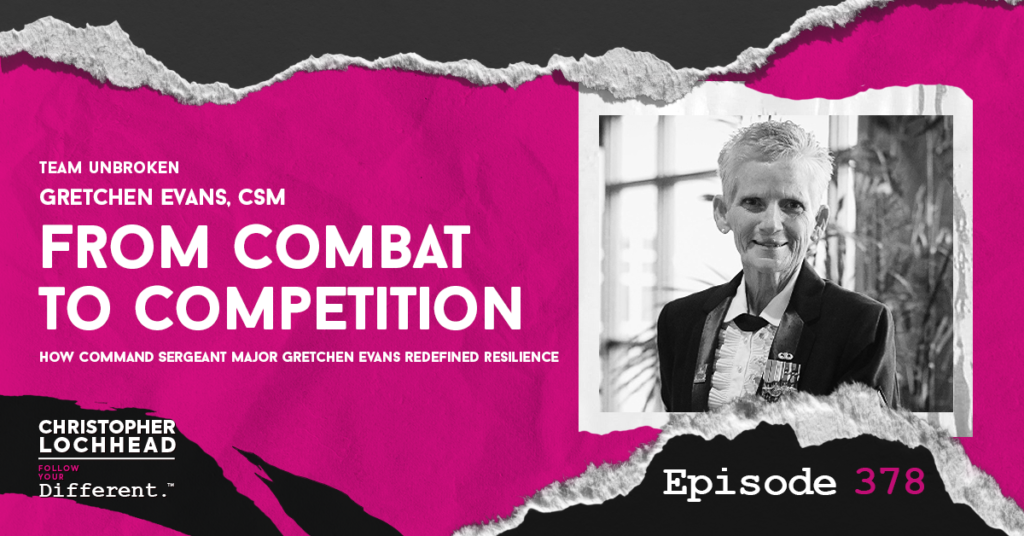
Podcast: Play in new window | Download (Duration: 1:36:24 — 44.1MB) | Embed
Subscribe: Apple Podcasts | Spotify | Pandora | RSS | More
On this episode of Christopher Lochhead: Follow Your Different, we engage in a profound conversation with Command Sergeant Major Gretchen Evans, a decorated veteran who served 27 years in the U.S. Army.
Gretchen shares her inspiring journey, from her motivations for joining the military to her experiences as one of the few women in a male-dominated environment. She discusses the challenges she faced, including injuries that led to her hearing loss, and her post-military work with Team Unbroken, an adaptive athletic team she founded.
Gretchen Evans’ story is one of resilience, leadership, and unwavering dedication to service.
You’re listening to Christopher Lochhead: Follow Your Different. We are the real dialogue podcast for people with a different mind. So get your mind in a different place, and hey ho, let’s go.
Honoring Veterans and Their Service: Command Sergeant Major Gretchen Evans
Christopher opens the episode by expressing his deep respect for veterans and the critical role they play in society. He then introduces Command Sergeant Major Gretchen Evans, highlighting her remarkable journey and the challenges she faced, including injuries sustained in combat that led to her hearing loss.
Christopher emphasizes Gretchen’s role as an inspiration, both during her military career and in her life after service, particularly through her work with Team Unbroken, an adaptive athletic team for veterans and civilians who have faced life-altering injuries or trauma.
Early Motivations and Joining the Military
Gretchen shares her motivations for joining the military, which were born out of necessity. After losing her parents at a young age, her older brother became her guardian. Struggling to make ends meet while juggling college and work, she was inspired by her father, a World War II veteran, and the values instilled in her.
She decided to enlist in the military, finding a welcoming environment in the Army after being turned away by other branches due to her height.
Breaking Barriers as a Woman in the Military
When Gretchen Evans enlisted in 1979, there were very few women in combat roles. She reflects on the challenges of being one of the few women in a male-dominated environment, particularly during basic training.
Despite the tough leadership from Vietnam veterans who were not accustomed to training women, Evans expresses gratitude for the rigorous training she received, which prepared her for the realities of military life.
She shares her first experience of being deployed to a combat zone in Grenada in 1983, describing the mix of nerves and excitement she felt. Despite her youth and inexperience, she relied on her training and the guidance of her leaders to navigate the chaotic environment.
To hear more from Gretchen Evans and her inspiring story of never giving up, download and listen to this episode.
Bio
Command Sergeant Major Gretchen Evans is a highly decorated U.S. Army veteran, motivational speaker, and author.
With over 27 years of service, she served as a senior intelligence analyst and paratrooper in multiple combat zones, including Afghanistan, where a mortar blast resulted in a traumatic brain injury and hearing loss.
Despite her injury, Evans continues to inspire through her resilience, sharing her journey in overcoming adversity. She leads Team UNBROKEN, the first all-disabled team in the “World’s Toughest Race” on Amazon Prime, promoting awareness about disability and perseverance.
Links
Follow Command Sergeant Major Gretchen Evans!
Team UNBROKEN | LinkedIn | Instagram
We hope you enjoyed this episode of Christopher Lochhead: Follow Your Different™! Christopher loves hearing from his listeners. Feel free to email him, connect on Facebook, Twitter, Instagram, and subscribe on iTunes!

